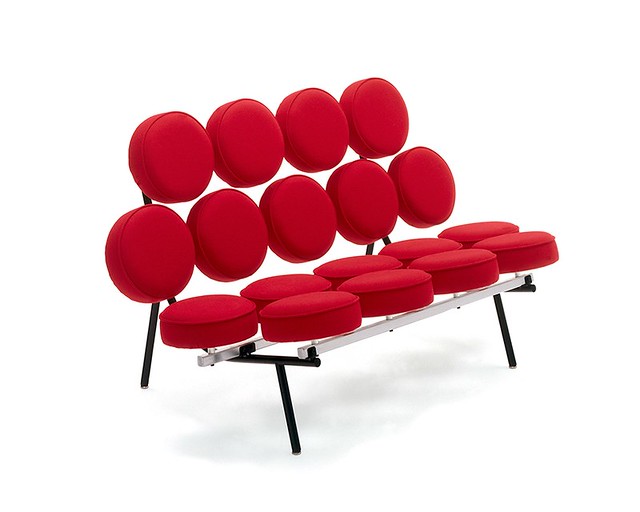
Herman Miller is an innovative furniture manufacturer with diverse creations that include Mid Century Modern classics such as the Marshmallow Sofa as well as the invention of the cubicle. After WWII, they began to collaborate with some of the design greats of the Twentieth century. These include the Eameses, George Nelson, Alexander Girard, Isamu Noguchi and Buckminster Fuller. While these designers are known for designing furniture, interiors and architecture, they were also involved in graphic design. In fact, George Nelson received an AIGA medal in 1992, post mortem.
One of the aspects that I admire most about Herman Miller is the devotion not only to aesthetics, but also to design thinking and experimentation on a deeper level. Don Chadwick of Herman Miller has said “Herman Miller does a lot of investing in ideas that never make it.”
Also, you can sit in Don Draper’s chair.
I attended a Continuing Education Unit about George Nelson at the Herman Miller showroom. It was a unique experience to hear stories about how these important pieces were designed in Nelson’s own voice while being able to see the actual pieces. Nelson’s formal training was in architecture. He became well known as a furniture designer, an industrial designer, an interior designer and exhibition designer. He referred to himself simply as a designer but some of his greatest accomplishments were as a writer. As an architectural student in Rome in the 30’s, he travelled Europe and interviewed leading modern architects. By getting these articles published in the U.S. he introduced the U.S. design community to the European avant-garde.
The lecture ended with these things that Tom Pratt, former Herman Miller executive, said about George Nelson in his eulogy:
He was incredulous at the thought that design would have any other purpose than to improve the quality of life in the built environment.
He believed that designers didn’t so much create as discover and that to address a problem by starting out to innovate was a sure-fire way to miss the solution altogether.
He cautioned about being too serious in the pursuit of design excellence lest one miss the joy of the activity.
He fretted about the inaccurate use of words that confused the real content of one’s meaning.
He fought narrow views and closed-mindedness and struggled to keep the minds of those he cared about open.
He disagreed loudly with the notion of growth equaling progress and worked hard to point out that in fact, though counter-intuitive in our society, it might be just the opposite.
He believed that revolutionary research started many times with throwing out what was known and starting over with the unknown.
He loathed the notion that any man would truly believe that he held the truth exclusive of any other man.


